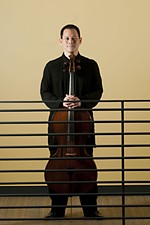Richard Stoltzman and Emanuel Ax
Local Arts Reviews
Reviewed by Jerry Young, Fri., April 25, 2003
Richard Stoltzman/Emanuel Ax:
Crystalline Landscape in a CavernBass Concert Hall, April 15
Hearing clarinetist Richard Stoltzman and pianist Emanuel Ax at Bass Concert Hall is like watching chess at Memorial Stadium. This is no place for chamber music; especially as played by Stoltzman, who is master of the intimate nature of his instrument. Ax invited the audience to move closer to the stage, but the space left the musicians and the audience at a disappointing disadvantage.
Rather than forsaking tone to fill the space, Stoltzman took a whispery approach to Robert Schumann's Fantasy Pieces. His timbre is reminiscent of shakuhachi playing -- deftly shaded colors and long gently flowing lines. It's hard to hear the point of articulation where each pitch in a melody begins and ends. The degree of difficulty was upped by his slower than usual tempos. But the sense of ensemble was not up to this pair's standards -- although some of that may have been due to the less-than-optimal setting. Too often, phrasing and dynamics headed off into different directions.
Like Benny Goodman, Stoltzman straddles the classical, contemporary, and jazz repertoires. All three were represented in the tuneful Largo Dolorosa from a sonata by Stoltzman's longtime colleague, William Thomas McKinley. Here Stoltzman stretched out, at times invoking the plaintive spirit of a soprano sax out of his instrument. In the notes, McKinley describes this work as an effort to draw on a broad range of emotional, dynamic, and technical possibilities, but one must assume that this slow movement stands in contrast to the others we didn't hear and was too ingratiatingly melodic to stand well on its own.
Yehudi Wyner's Commedia, freshly composed to celebrate a "significant birthday" for Stoltzman, did show that breadth. Through its musical exploration of commedia dell'arte characters, the pair joked, danced, and argued ferociously. Stoltzman has championed new music throughout his career, so his brilliance in this piece came as no surprise. Although new music has become more a part of Ax's repertoire recently, this was the first chance to hear him performing such work in Austin. He brought the same relish and authority to it that he brings to Chopin and Beethoven. On some future trip here, I hope we can hear him play Alban Berg or Schoenberg.
Brahms' two clarinet sonatas were the main course. The E-Flat Sonata, Op. 120, No. 2 suffered from similar problems as the Schumann, as if it has not yet jelled. There were impressive moments throughout -- more often individually than collectively. At times one could sense Ax holding back in places where Stoltzman wanted to explore softer dynamics.
Everything was in place for the F-Minor Sonata, Op. 120, No 1, and here was that collegial interplay that one expected from these two seasoned musicians. The slow movement was dangerously slow and controlled, examining the microscopic details that gust up into big harmonic changes. It was succinct and expressive. Using thoughtfully placed articulation to unfold each phrase, the musicians brought us up to the surface of this work without losing track of how it fits into the big picture. This almost crystalline landscape was countered by the virtuosic romp of the finale, planting music in your head that could lure you into a speeding ticket on your way home.










